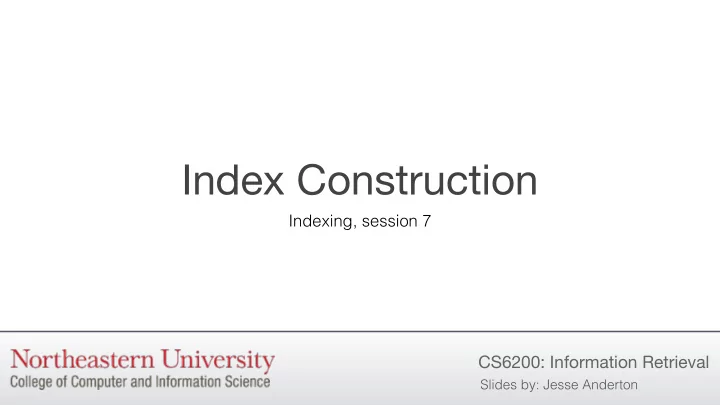

Index Construction Indexing, session 7 CS6200: Information Retrieval Slides by: Jesse Anderton
Basic Indexing Given a collection of documents, how can we efficiently create an inverted index of its contents? Basic In-Memory Indexer The basic steps are: 1. Tokenize each document, to convert it to a sequence of terms 2. Add doc to inverted list for each token This is simple at small scale and in memory, but grows much more complex to do efficiently as the document collection and vocabulary grow.
Merging Lists The basic indexing algorithm will fail as soon as you run out of memory. To address this, we store a partial inverted list to disk when it grows too large to handle. We reset the in-memory index and start over. When we’re finished, we merge all the partial indexes. The partial indexes should be written in a manner that facilitates later merging. For instance, store the terms in some reasonable sorted order. This permits merging with a single linear pass through all partial lists.
Merging Example
Result Merging An index can be updated from a new batch of documents by merging the posting lists from the new documents. However, this is inefficient for small updates. Instead, we can run a search against both old and new indexes and merge the result lists at search time. Once enough changes have accumulated, we can merge the old and new indexes in a large batch. In order to handle deleted documents, we also need to maintain a delete list of docids to ignore from the old index. At search time, we simply ignore postings from the old index for any docid in the delete list. If a document is modified, we place its docid into the delete list and place the new version in the new index.
Updating Indexes If each term’s inverted list is stored in a separate file, updating the index is straightforward: we simply merge the postings from the old and new index. However, most filesystems can’t handle very large numbers of files, so several inverted lists are generally stored together in larger files. This complicates merging, especially if the index is still being used for query processing. There are ways to update live indexes efficiently, but it’s often simpler to simply write a new index, then redirect queries to the new index and delete the old one.
Wrapping Up We have just scratched the surface of the complexities of constructing and updating large-scale indexes. The most complex indexes are massive engineering projects that are constantly being improved. An indexing algorithm needs to address hardware limitations (e.g., memory usage), OS limitations (the maximum number of files the filesystem can efficiently handle), and algorithmic concerns. When considering whether your algorithm is sufficient, consider how it would perform on a document collection a few orders of magnitude larger than it was designed for. Next, we’ll look at how to distribute indexing across a network.
Recommend
More recommend